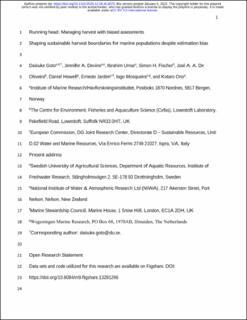| dc.description.abstract | Biased estimates of population status are a pervasive conservation problem. This problem has plagued assessments of commercial exploitation of marine species and can threaten the sustainability of both populations and fisheries. We develop a computer-intensive approach to minimize adverse effects of persistent estimation bias in assessments by optimizing operational harvest measures (harvest control rules) with closed-loop simulation of resource–management feedback systems: management strategy evaluation. Using saithe (Pollachius virens), a bottom-water, apex predator in the North Sea, as a real-world case study, we illustrate the approach by first diagnosing robustness of the existing harvest control rule and then optimizing it through propagation of biases (overestimated stock abundance and underestimated fishing pressure) along with select process and observation uncertainties. Analyses showed that severe biases lead to overly optimistic catch limits and then progressively magnify the amplitude of catch fluctuation, thereby posing unacceptably high overharvest risks. Consistent performance of management strategies to conserve the resource can be achieved by developing more robust control rules. These rules explicitly account for estimation bias through a computational grid search for a set of control parameters (threshold abundance that triggers management action, Btrigger, and target exploitation rate, Ftarget) that maximize yield while keeping stock abundance above a precautionary level. When the biases become too severe, optimized control parameters– for saithe, raising Btrigger and lowering Ftarget–would safeguard against overharvest risk (<3.5% probability of stock depletion) and provide short-term stability in catch limit (<20% year-to-year variation), thereby minimizing disruption to fishing communities. The precautionary approach to fine-tuning adaptive risk management through management strategy evaluation offers a powerful tool to better shape sustainable harvest boundaries for exploited resource populations when estimation bias persists. By explicitly accounting for emergent sources of uncertainty our proposed approach ensures effective conservation and sustainable exploitation of living marine resources even under profound uncertainty. | en_US |
